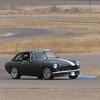
Formula Three in 1971
#1

Posted 10 May 2011 - 21:12
Please help me understand restrictor plate rules for Formula Three in 1971.
As I've read, 1971 F3 rules at the start of the season permitted 1.6L engines IF they breathed through a 20mm restriction...
Should I understand that to be a SINGLE 20mm restriction, or was it in fact a 20mm restriction per cylinder/throttle?
I've also read that the rule was altered in mid season (mid August?) and that the 20mm spec was increased to 24mm. Can someone please confirm or refute that?
A photo might be worth a thousand words here, but I haven't found one that shows the induction system on these 1.6L engines.
How much power do you guys figure these engines produced, before and after the rule change?
Thanks!
Advertisement
#2

Posted 10 May 2011 - 22:02
#3

Posted 11 May 2011 - 06:41
A photo might be worth a thousand words here, but I haven't found one that shows the induction system on these 1.6L engines.
This was taken around 1972. Not sure if it's any help.

#4

Posted 11 May 2011 - 08:17
Definately one restrictor at the forward end of the intake manifold.This was taken around 1972. Not sure if it's any help.
If the the intake manifold happened not to be sealed very well after the restrictor, then extra air could find it's way into the engine with a possible performance increase.
But I think the scrutineers had a fairly good hold on this with a presure test.
#5

Posted 11 May 2011 - 08:23
Simples!
#6

Posted 11 May 2011 - 08:43

With the advent of tea bags is there now a shortage of tea strainers to fit in front of the restrictors
Edited by alansart, 11 May 2011 - 14:50.
#7

Posted 11 May 2011 - 09:14
21.5 in 1972.According to my FIA Yearbooks for 1971 and 1973 (I don't have 1972) the restrictor size specified for 1971 was 20 mm. This haad been increased to 21.5 mm for 1973, but I don't know exactly when the change occurred. The air for all cylinders had to pass through the single restrictor.
#8

Posted 11 May 2011 - 09:29
We ran the ex.Bev Bond car for 2 seasons (713) and whilst they are nice cars they lack serious performance and are in fact slower than even Historic FF1600 cars .
Its a pity that there aren't enough folks willing to bring out their 1600 F3 cars as I'm sure that if they could run a stand alone series they would be very popular instead of running well at the rear of the Classic F3 C/Ship when competing with the 2.0 litre cars .
We did suggest that the cars be allowed to run larger restrictor orifice for better performance but this was decided against so with an 18 stone driver we decided to move on .
Nice cars however and definitely run faster with no wings .
#9

Posted 11 May 2011 - 14:48
I'm certain that the ex. Keegan car pictured is a 734 therefore a 2.0 litre car .
Simon Hadfield's Rupert Keegan March is a 743.
#10

Posted 11 May 2011 - 14:50
Simon Hadfield's Rupert Keegan March is a 743.
Yes it is.
Original post corrected
#11

Posted 11 May 2011 - 15:22
Very helpful - thank you!
#12

Posted 11 May 2011 - 16:01
#13

Posted 11 May 2011 - 16:15
To give you some information.
In 1971 the first few races held had 1600cc engines with a 20mm restrictor. If I remember correctly the first 3 or 4 races. The first race in the UK at Mallory Park had only 4 enteries and the race was run with the Forumla Fords. The engines were very underpowered at 20mm.
Very quicky there was a re-think and the restrictor size was increased to 21.5mm. That is where it remained until the 2000cc formula was introduced in 1974.
Some information can be found here
Go to Races-1971 etc.
There was some great racing in the UK. Walker, Williamson, Bond, Hunt, Maskell, Sutcliffe etc.
I hope this helps.
Charlie















